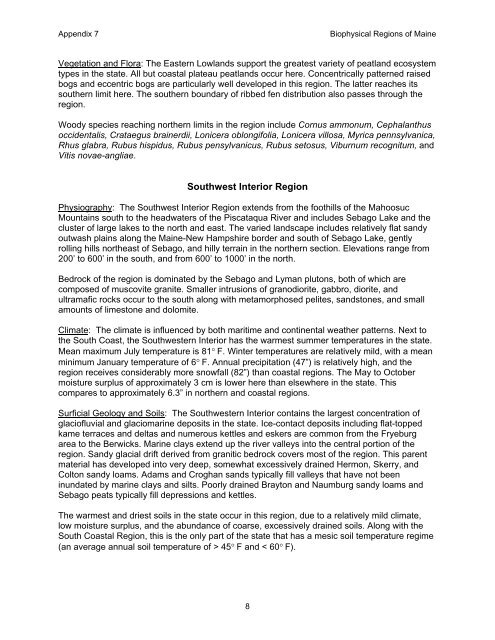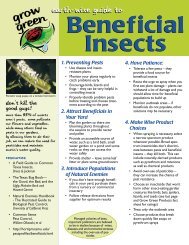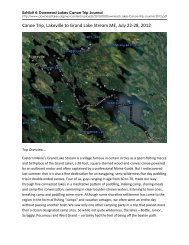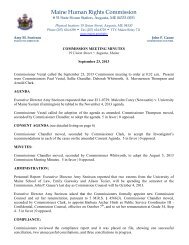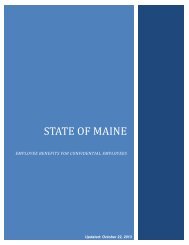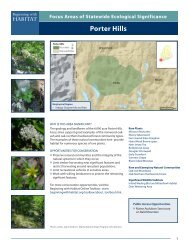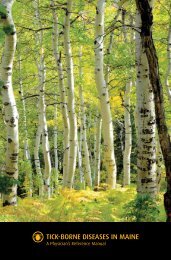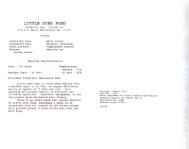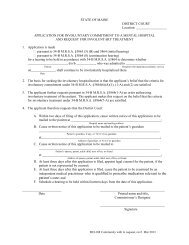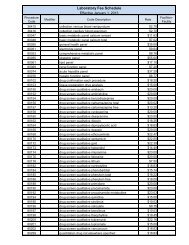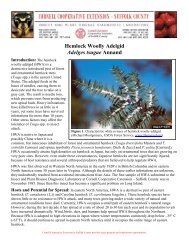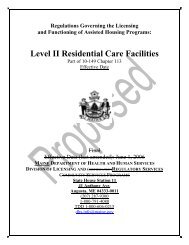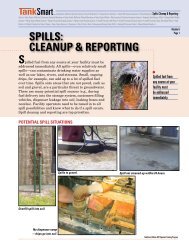BIOPHYSICAL REGIONS - Maine.gov
BIOPHYSICAL REGIONS - Maine.gov
BIOPHYSICAL REGIONS - Maine.gov
You also want an ePaper? Increase the reach of your titles
YUMPU automatically turns print PDFs into web optimized ePapers that Google loves.
Appendix 7 Biophysical Regions of <strong>Maine</strong><br />
Vegetation and Flora: The Eastern Lowlands support the greatest variety of peatland ecosystem<br />
types in the state. All but coastal plateau peatlands occur here. Concentrically patterned raised<br />
bogs and eccentric bogs are particularly well developed in this region. The latter reaches its<br />
southern limit here. The southern boundary of ribbed fen distribution also passes through the<br />
region.<br />
Woody species reaching northern limits in the region include Cornus ammonum, Cephalanthus<br />
occidentalis, Crataegus brainerdii, Lonicera oblongifolia, Lonicera villosa, Myrica pennsylvanica,<br />
Rhus glabra, Rubus hispidus, Rubus pensylvanicus, Rubus setosus, Viburnum recognitum, and<br />
Vitis novae-angliae.<br />
Southwest Interior Region<br />
Physiography: The Southwest Interior Region extends from the foothills of the Mahoosuc<br />
Mountains south to the headwaters of the Piscataqua River and includes Sebago Lake and the<br />
cluster of large lakes to the north and east. The varied landscape includes relatively flat sandy<br />
outwash plains along the <strong>Maine</strong>-New Hampshire border and south of Sebago Lake, gently<br />
rolling hills northeast of Sebago, and hilly terrain in the northern section. Elevations range from<br />
200’ to 600’ in the south, and from 600’ to 1000’ in the north.<br />
Bedrock of the region is dominated by the Sebago and Lyman plutons, both of which are<br />
composed of muscovite granite. Smaller intrusions of granodiorite, gabbro, diorite, and<br />
ultramafic rocks occur to the south along with metamorphosed pelites, sandstones, and small<br />
amounts of limestone and dolomite.<br />
Climate: The climate is influenced by both maritime and continental weather patterns. Next to<br />
the South Coast, the Southwestern Interior has the warmest summer temperatures in the state.<br />
Mean maximum July temperature is 81° F. Winter temperatures are relatively mild, with a mean<br />
minimum January temperature of 6° F. Annual precipitation (47”) is relatively high, and the<br />
region receives considerably more snowfall (82”) than coastal regions. The May to October<br />
moisture surplus of approximately 3 cm is lower here than elsewhere in the state. This<br />
compares to approximately 6.3” in northern and coastal regions.<br />
Surficial Geology and Soils: The Southwestern Interior contains the largest concentration of<br />
glaciofluvial and glaciomarine deposits in the state. Ice-contact deposits including flat-topped<br />
kame terraces and deltas and numerous kettles and eskers are common from the Fryeburg<br />
area to the Berwicks. Marine clays extend up the river valleys into the central portion of the<br />
region. Sandy glacial drift derived from granitic bedrock covers most of the region. This parent<br />
material has developed into very deep, somewhat excessively drained Hermon, Skerry, and<br />
Colton sandy loams. Adams and Croghan sands typically fill valleys that have not been<br />
inundated by marine clays and silts. Poorly drained Brayton and Naumburg sandy loams and<br />
Sebago peats typically fill depressions and kettles.<br />
The warmest and driest soils in the state occur in this region, due to a relatively mild climate,<br />
low moisture surplus, and the abundance of coarse, excessively drained soils. Along with the<br />
South Coastal Region, this is the only part of the state that has a mesic soil temperature regime<br />
(an average annual soil temperature of > 45° F and < 60° F).<br />
8


